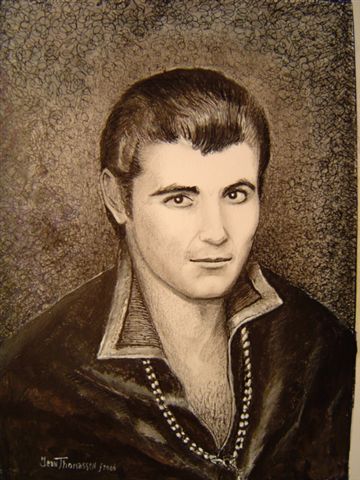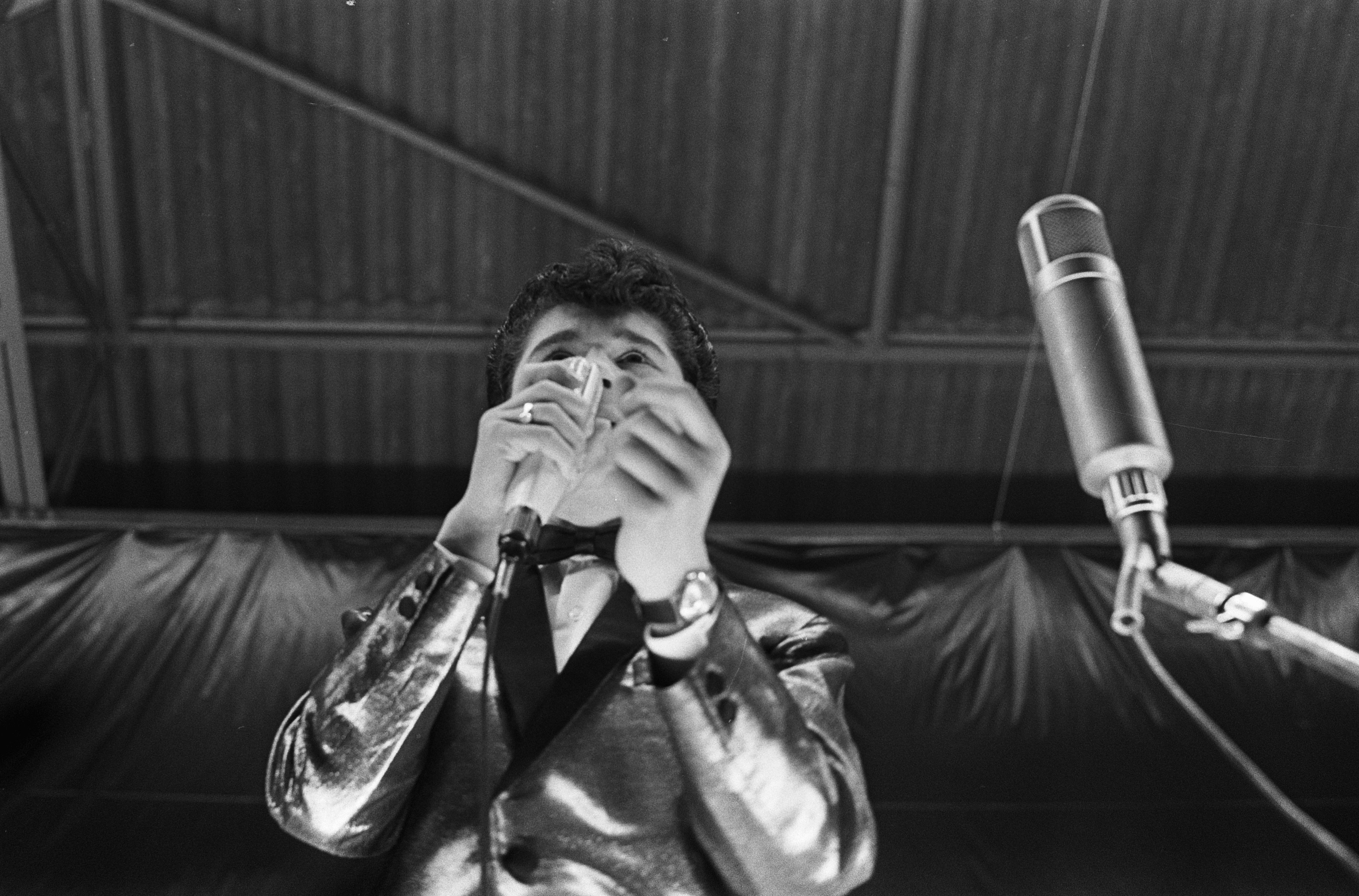1. Overview
Vince Taylor (born Brian Maurice Holden; 14 July 1939 - 28 August 1991) was an English-American rock and roll singer. As the dynamic frontman of Vince Taylor and His Playboys, he achieved significant success primarily in France and other parts of Continental Europe during the late 1950s and early 1960s. Despite his electrifying stage presence, his career eventually faltered due to personal struggles and drug abuse, leading him into obscurity. Taylor is widely recognized for his influential 1959 song "Brand New Cadillac", which was famously covered by the Clash on their acclaimed album London Calling. Beyond his musical contributions, Taylor is also celebrated for serving as the primary inspiration for David Bowie's iconic Ziggy Stardust persona, a fact confirmed by Bowie himself.

2. Life
Vince Taylor's life was marked by early international moves, a meteoric rise in the European rock and roll scene, and a subsequent decline due to personal challenges, before finding peace in his later years.
2.1. Early life and background
Brian Maurice Holden was born on 14 July 1939 in Isleworth, Middlesex, England. When he was seven years old, his family, the Holdens, emigrated to America. They initially settled in New Jersey, where his father secured employment. Around 1955, his sister Sheila married Joseph Barbera, a co-founder of Hanna-Barbera, who would later become Taylor's brother-in-law and briefly his manager. This marriage led the family to relocate to California, where Taylor attended Hollywood High School. During his teenage years, Taylor developed an interest in aviation, taking flying lessons and successfully obtaining a pilot's license.
2.2. Music career
Vince Taylor's music career was characterized by bursts of success, particularly in Europe, often followed by internal band disputes and personal difficulties.
2.2.1. Early success and "Brand New Cadillac"
At the age of 18, deeply impressed by the music of rock and roll pioneers like Gene Vincent and Elvis Presley, Taylor began singing, initially performing at amateur gigs. While in London during the summer of 1958, he visited The 2i's Coffee Bar on Old Compton Street in Soho, a popular venue where Tommy Steele often performed. It was there that he met drummer Tony Meehan (who would later join the Shadows) and bass player Tex Makins (born Anthony Paul Makins on 3 July 1940, in Wembley, Middlesex). Together, they formed a band which they named The Playboys. Seeking a suitable stage name, Taylor observed the Latin phrase "In hoc signo vinces" on a packet of Pall Mall cigarettes, which inspired him to adopt the stage name Vince Taylor.
His initial singles, "I Like Love" and "Right Behind You Baby," were released by Parlophone in 1958. Several months later, Parlophone issued "Pledgin' My Love," with "Brand New Cadillac" featured on the B-side. The latter track notably included guitarist Joe Moretti, who would later contribute to "Shakin' All Over" by Johnny Kidd & the Pirates. Dissatisfied with the immediate commercial results, Parlophone terminated Taylor's recording contract. He then signed with Palette Records, releasing "I'll Be Your Hero" backed with "Jet Black Machine" on 19 August 1960. "Brand New Cadillac" has since gained recognition as a pivotal song in the evolution of British rock and roll. The song became a significant hit across continental Europe through chart-topping cover versions by bands such as the Renegades, Hep Stars, and the Shamrocks in Finland, Sweden, and France, respectively. On 23 April 1960, ABC Weekend TV launched its new weekly rock and roll television program, Wham!, featuring Taylor alongside other notable artists like Dickie Pride, Billy Fury, Joe Brown, Jess Conrad, Little Tony, and Johnny Kidd & the Pirates in its debut episode.
2.2.2. European tours and challenges
Despite his electrifying and dynamic presence on stage, Taylor's unpredictable personality frequently led to arguments within his band. In 1961, The Playboys decided to part ways with him, subsequently renaming themselves the Bobbie Clarke Noise. Under this new name, they secured a contract to perform at the prestigious Paris Olympia in July 1961, where Wee Willie Harris was the headline act. Taylor, who had maintained contact with the band, requested to rejoin them in Paris. For the sound check, he appeared in his signature black leather stage attire, adding a chain around his neck adorned with a Joan of Arc medallion he had acquired upon arriving in Calais. Accounts suggest that Taylor delivered such an extraordinary performance during the sound check that the organizers decided to promote him to the top of the bill for both shows. This standout performance resulted in Eddie Barclay signing Taylor to a six-year recording deal with his Barclay record label.

Throughout 1961 and 1962, Taylor extensively toured Europe with Clarke's band, which once again performed under the name Vince Taylor and His Playboys. Between concert dates, they recorded several EPs and a 20-song album at Barclay Studios in Paris. These recordings included numerous popular cover versions such as "Sweet Little Sixteen", "C'mon Everybody", "Twenty Flight Rock", "Love Me", "Long Tall Sally", "So Glad You're Mine", "Baby Let's Play House", and "Lovin' Up A Storm". By the end of 1962, Vince Taylor and the Playboys were headlining at the Olympia in Paris, with Sylvie Vartan serving as their opening act.
However, despite their strong on-stage chemistry, the off-stage relationship between Taylor and the Playboys continued to deteriorate, leading to another dissolution of the band. Taylor subsequently performed several engagements backed by the English band the Echoes, who also regularly supported Gene Vincent during his UK performances. Nonetheless, Taylor continued to present this backing band as The Playboys. In February 1964, a new single featuring "Memphis Tennessee" on the A-side and "A Shot of Rhythm and Blues" on the B-side was released on the Barclay label. The Playboys at this time consisted of Joey Greco and Claude Djaoui on guitars, Ralph Di Pietro on bass, and Bobbie Clarke on drums. This group was under contract to the Johnny Hallyday orchestra. During this period, Taylor also appeared in four Scopitones, which were early music video-like films, for his songs "Twenty Flight Rock," "Shakin' All Over," "Peppermint Twist," and "There's a Whole Lot of Twistin' Goin' On."
After Johnny Hallyday was required to complete national service in the French Army, Clarke once again collaborated with Taylor, forming a new iteration of the Bobbie Clarke Noise. This lineup included Ralph Danks on guitar, Alain Bugby of the Strangers on bass, Johnny Taylor (formerly the lead singer for the Strangers) on rhythm guitar, and "Stash de Rola" Prince Stanislas Klossowski de Rola on percussion. Managed by Jean Claude Camus, the band embarked on a successful tour of Spain. Following this, they co-headlined with the Rolling Stones during the Easter weekend of 1965 at the Olympia in Paris.
2.2.3. Decline and intermittent activities
Following the Paris Olympia performance, the band disbanded. Taylor began facing significant struggles with alcohol and other drugs, eventually joining a religious movement. Meanwhile, former band members moved on to other projects: Danks played guitar with Three Dog Night, and later with prominent artists such as Tom Jones, Elvis Presley, and Bob Dylan. Stash, a close friend of the Rolling Stones, went on to produce the Dirty Strangers album, which featured Keith Richards and Ronnie Wood. Clarke replaced drummer Don Conka for several studio sessions with the original lineup of the band Love. He also performed with Vince Flaherty and his band The Invincibles, Frank Zappa, Jimi Hendrix, and the initial incarnation of Deep Purple, before forming his own group, Bodast, with Steve Howe and Dave Curtis. In 1968, Bodast recorded an album for MGM Records, opened for the Who, and served as the backing band for Chuck Berry at the Royal Albert Hall in London.
Despite Taylor's personal struggles, Bobbie Clarke remained committed to his friend's career and actively worked on a comeback. This effort culminated in a one-month tour across France, billed as 'Vince Taylor and Bobbie Clarke backed by Les Rockers'. Eddie Barclay, who had previously signed Taylor, offered him another opportunity to record. Taylor continued to record new material and performed intermittently throughout the 1970s and 1980s until his death.
2.3. Later life and death
In the later part of his life, Vince Taylor settled in Switzerland, where he had resided since 1983. During this period, he found a new profession and worked as an aircraft mechanic, a role he described as the happiest time of his life.
Vince Taylor died from lung cancer in August 1991, at the age of 52. He was buried in Lausanne, Switzerland. He had lived in Switzerland with his wife, Nathalie (née Minster), and his step-daughter, Magaly.
3. Legacy and influence
Vince Taylor's unique stage persona and turbulent career left a lasting mark on music and popular culture, particularly inspiring future artists.
3.1. Inspiration for David Bowie's Ziggy Stardust
One of Taylor's most significant legacies is his profound influence on David Bowie's creation of the iconic Ziggy Stardust character. Bowie explicitly stated that Taylor was the main inspiration for Ziggy Stardust, citing Taylor's wild lifestyle and unpredictable nature as key elements that shaped the fictional rock star's persona.
3.2. Cultural references and tributes
Taylor's life and music have been acknowledged and honored in various forms across popular culture:
- Sha Na Na guitarist Chris Donald adopted the stage name Vinnie Taylor, which is believed to be a tribute to Vince Taylor.
- The Dutch rock band Golden Earring referenced Taylor in their 1973 album Moontan with the song "Just Like Vince Taylor." This track served as the US B-side to their well-known hit, "Radar Love."
- In 1997, the Clash's lead singer Joe Strummer portrayed a character inspired by Taylor in F. J. Ossang's road movie Docteur ChanceDoctor ChanceFrench. Strummer's character was an ex-rock star who had become a private aviator.
- Northern Irish singer Van Morrison explicitly mentions Taylor in his 1999 song "Goin' Down Geneva," with the lyrics: "Vince Taylor used to live here/No one's even heard of him/Just who he was/Just where he fits in." Morrison later integrated parts of "Brand New Cadillac" into his live performances of "Going Down Geneva."
- Adam Ant co-wrote and recorded a song titled "Vince Taylor" with Boz Boorer for his 2013 album Adam Ant Is the Blueblack Hussar in Marrying the Gunner's Daughter. The song serves as a tribute to Taylor and also recounts the story of a gold-plated chain that Taylor gave to his French girlfriend Valerie, who later passed it to Adam Ant. Ant has further claimed that he used this chain as a weapon, wrapped around his fist, during a confrontation with Sid Vicious.
3.3. Family and later recognition
Vince Taylor had a son, Ty Holden, who publicly stated on BBC Radio 4 that his father was largely absent during his upbringing. Ty Holden was a member of the indie band Crown of Thorns, which was managed by Miles Copeland III. Ty Holden is currently known as a DJ within the London underground dance scene.
On 18 August 2010, BBC Radio 4 aired a documentary titled Ziggy Stardust Came from Isleworth. According to the producer, the program aimed to "uncover the truth about a singer whose wild lifestyle ultimately destroyed him, but in so doing he gave rise to a myth that transcended glam-rock and science fiction," further solidifying Taylor's lasting impact and mystique.